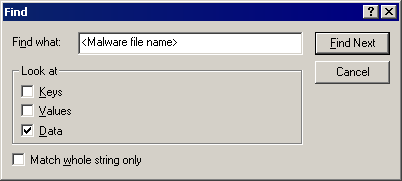TROJ_VUNDO.KQD
Trojan:Win32/Vundo.IX (Microsoft); Trojan.Win32.Monderd.gen (Kaspersky); Vundo (McAfee); Troj/Virtum-Gen (Sophos); Trojan.Vundo.Gen.4 (FSecure); Trojan.Win32.Monder.gen.1 (Sunbelt); Trojan.Win32.Monderd (Ikarus)
Windows 2000, Windows XP, Windows Server 2003


Threat Type: Trojan
Destructiveness: No
Encrypted: Yes
In the wild: Yes
OVERVIEW
Downloaded from the Internet
This Trojan arrives on a system as a file dropped by other malware or as a file downloaded unknowingly by users when visiting malicious sites.
It lowers the security setting of Internet Explorer.
TECHNICAL DETAILS
238,592 bytes
DLL
Yes
22 Jun 2009
Drops files
Arrival Details
This Trojan arrives on a system as a file dropped by other malware or as a file downloaded unknowingly by users when visiting malicious sites.
Installation
This Trojan drops the following non-malicious file:
- %System%\bb911232-.txt
(Note: %System% is the Windows system folder, which is usually C:\Windows\System on Windows 98 and ME, C:\WINNT\System32 on Windows NT and 2000, or C:\Windows\System32 on Windows XP and Server 2003.)
It injects itself into the following processes running in the affected system's memory:
- explorer.exe
Autostart Technique
This Trojan adds the following registry entries to enable its automatic execution at every system startup:
HKEY_CLASSES_ROOT\CLSID\{random CLSID}\
InprocServer32
{default} = "{malware path}\{malware name}.dll"
HKEY_LOCAL_MACHINE\SOFTWARE\Classes\
CLSID\{random CLSID}\InprocServer32
{default} = "{malware path}\{malware name}.dll"
It registers itself as a BHO to ensure its automatic execution every time Internet Explorer is used by adding the following registry keys:
HKEY_LOCAL_MACHINE\SOFTWARE\Microsoft\
Windows\CurrentVersion\Explorer\
Browser Helper Objects\{random CLSID}
Other System Modifications
This Trojan adds the following registry entries as part of its installation routine:
HKEY_CLASSES_ROOT\CLSID\{random CLSID}\
InprocServer32
ThreadingModel = "Both"
HKEY_LOCAL_MACHINE\SOFTWARE\Classes\
CLSID\{random CLSID}\InprocServer32
ThreadingModel = "Both"
It modifies the following registry key(s)/entry(ies) as part of its installation routine:
HKEY_LOCAL_MACHINE\SYSTEM\CurrentControlSet\
Services\wuauserv
Start = "4"
(Note: The default value data of the said registry entry is 2.)
It adds the following registry keys as part of its installation routine:
HKEY_CLASSES_ROOT\CLSID\{random CLSID}
HKEY_CLASSES_ROOT\CLSID\{random CLSID}\
InprocServer32
HKEY_LOCAL_MACHINE\SOFTWARE\Classes\
CLSID\{random CLSID}
HKEY_LOCAL_MACHINE\SOFTWARE\Classes\
CLSID\{random CLSID}\InprocServer32
HKEY_LOCAL_MACHINE\SOFTWARE\Microsoft\
{random characters}
HKEY_LOCAL_MACHINE\SOFTWARE\Microsoft\
FCOVM
HKEY_LOCAL_MACHINE\SOFTWARE\Microsoft\
RemoveRP
Web Browser Home Page and Search Page Modification
This Trojan lowers the security setting of Internet Explorer.
Dropping Routine
This Trojan drops the following files:
- {malware path}\{malware filename}.ini - detected as Mal_VundoG
- {malware path}\{malware filename}.ini2 - detected as Mal_VundoG
Download Routine
This Trojan connects to the following website(s) to download and execute a malicious file:
- http://{BLOCKED}.169.55/i.exe?setid={data}&affid={data}&uid=&rid={data}&guid={guid}
SOLUTION
9.200
6.214.03
22 Jun 2009
6.215.00
23 Jun 2009
Step 1
For Windows XP and Windows Server 2003 users, before doing any scans, please make sure you disable System Restore to allow full scanning of your computer.
Step 3
Restart in Safe Mode
Step 4
Delete this registry key
Important: Editing the Windows Registry incorrectly can lead to irreversible system malfunction. Please do this step only if you know how or you can ask assistance from your system administrator. Else, check this Microsoft article first before modifying your computer's registry. Before you could do this, you must restart in Safe Mode. For instructions on how to do this, you may refer to this page If the preceding step requires you to restart in safe mode, you may proceed to edit the system registry.
- In HKEY_LOCAL_MACHINE\SOFTWARE\Microsoft
- {random characters}
- {random characters}
- In HKEY_LOCAL_MACHINE\SOFTWARE\Microsoft
- FCOVM
- FCOVM
- In HKEY_LOCAL_MACHINE\SOFTWARE\Microsoft
- RemoveRP
- RemoveRP
Step 5
Delete the created random CLSID key
Important: Editing the Windows Registry incorrectly can lead to irreversible system malfunction. Please do this step only if you know how or you can ask assistance from your system administrator. Else, check this Microsoft article first before modifying your computer's registry.
Step 6
Restore this modified registry value
Important: Editing the Windows Registry incorrectly can lead to irreversible system malfunction. Please do this step only if you know how or you can ask assistance from your system administrator. Else, check this Microsoft article first before modifying your computer's registry.
- In HKEY_LOCAL_MACHINE\SYSTEM\CurrentControlSet\Services\wuauserv
- From: Start = "4"
To: Start = 2
- From: Start = "4"
Step 7
Search and delete these files
- %System%\bb911232-.txt
Step 8
Scan your computer with your Trend Micro product to delete files detected as TROJ_VUNDO.KQD. If the detected files have already been cleaned, deleted, or quarantined by your Trend Micro product, no further step is required. You may opt to simply delete the quarantined files. Please check this Knowledge Base page for more information.
Did this description help? Tell us how we did.


